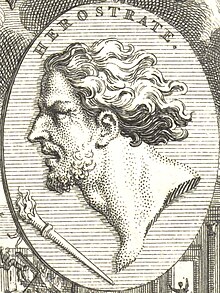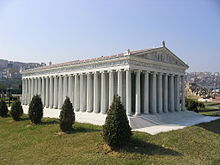Herostratus | |
|---|---|
| Ἡρόστρατος | |
 Non-contemporary depiction | |
| Born | |
| Died | c. 356 BC Ephesus |
| Cause of death | Execution |
| Nationality | Ephesian |
| Known for | Destroying the Temple of Artemis at Ephesus—and, concomitantly, seeking fame at any cost |
Herostratus (Ancient Greek: Ἡρόστρατος) was a 4th-century BC Greek, accused of seeking notoriety as an arsonist by destroying the second Temple of Artemis in Ephesus (on the outskirts of present-day Selçuk), one of the Seven Wonders of the Ancient World. The act prompted his execution and the creation of a damnatio memoriae law forbidding anyone to mention his name, orally or in writing. The law was ultimately ineffective, as evidenced by surviving accounts of his crime. Thus, Herostratus has become an eponym for someone who commits a criminal act in order to become famous.

Archeological evidence indicates the site of the Temple of Artemis at Ephesus had been of sacred use since the Bronze Age,[1] and the original building was destroyed during a flood in the 7th century BC.[2] A second temple was commissioned by King Croesus of Lydia around 560 BC and built by Cretan architects including Chersiphron, constructed largely of marble, and measuring 103 metres (337 ft) long and 55 metres (180 ft) wide with its pillars standing 12 metres (40 ft) tall.[3] The sculpted bases of the pillars contained life-sized carvings and the roof opened to the sky around a statue of Artemis.[3] The second temple was included on an early list of the Seven Wonders of the Ancient World by Herodotus in the 5th century BC, and was well known in ancient times.[4]
Little is known about the life of Herostratus, though it is thought he may have been someone of low social standing, a non-Ephesian or a slave.[5] According to tradition, the fire that destroyed the second temple was set on the day Alexander the Great was born, 21 July 356 BC.[3] Herostratus was then captured and tortured on the rack,[5] where he confessed to having committed the arson in an attempt to immortalize his name.[6] To dissuade those of similar intentions, the Ephesian authorities not only executed Herostratus, but attempted to condemn him to a legacy of obscurity by forbidding mention of his name under penalty of death. However, the ancient historian Theopompus, who was not Ephesian but rather Chian,[7] mentions the name of Herostratus in his Philippica,[8] and it appears again later in the works of Strabo.[9] It is said that in fact his name has outlived the names of his judges, and in his 1658 work Hydriotaphia Sir Thomas Browne states:
But the iniquity of oblivion blindly scattereth her poppy, and deals with the memory of men without distinction to merit of perpetuity. [...] Herostratus lives that burnt the Temple of Diana, he is almost lost that built it [...] Who knows whether the best of men be known? or whether there be not more remarkable persons forgot, than any that stand remembred in the known account of time?[10]
Work on a third temple at the site began in 323 BC, resulting in a larger and more ornate temple that would be included by Antipater of Sidon as one of Seven Wonders of the Ancient World.[11]: 417–418
Herostratus' name lived on in classical literature and has passed into modern languages as a term for someone who commits a criminal act in order to achieve notoriety. According to Julia H. Fawcett, Herostratus "exemplifies a figure asserting his right to self-definition, one who strikes out against a history to which he is unknown by performing himself back into that history—through whatever means necessary." The term "Herostratic fame" refers to Herostratus and means "fame [sought] at any cost".[12]: 33